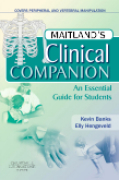
Maitland's clinical companion: an essential guide for students
Banks, Kevin
Hengeveld, Elly
Maitland's Clinical Companion is the ideal reference for students who need support during their neuromusculoskeletal clinical practice in areas such as communication, clinical reasoning, examination and assessment. It is a vital source for understanding the role of mobilisation and manipulation in helping to maximize the recovery, rehabilitation and functioning of patients with movement-related disorders.The principles of the Maitland Concept of Manipulative Physiotherapy are applied to each body region so as to guide the student through to the appropriate selection, application and progression of mobilisation and manipulation techniques within the context of contemporary physiotherapeutic rehabilitation.A vital companion to the classic texts - Vertebral and PeripheralManipulation - which promotes a patient-centred approach to neuromusculoskeletal disorders. INDICE: Section 1-PrinciplesChapter 1 How to use the Maitland Concept of Manipulative Physiotherapy in Clinical Practice: An overviewChapter 2 How to explain the Maitland concept to patients and to colleaguesChapter 3 How to define Mobilisation and ManipulationChapter 4 The evidence which supports the use of mobilisation /manipulation in clinical practiceChapter 5 Paradigms and Models: The overall role of mobilisation and manipulation in rehabilitation and clinical practiceChapter 6 Clinical Reasoning and the Maitland Concept of Manipulative PhysiotherapyChapter 7 How and when to assess and reassess the effect ofeach techniqueChapter 8 How to carry out an ordered, structured, and individualised NMSK [Movement] Examination8a-Format and aims of examination8b-Communication8c-Subjective Examination [C/O]8d-Planning Physical Examination 8e-Physical Examination [P/E]Chapter 9 How to decide when to use mobilisation and manipulation techniquesChapter 10 How to select and progress the most appropriate technique[s]Chapter 11 How to perform mobilisation and manipulation techniques effectivelyChapter 12 Neuromusculoskeletal disorders which are more likely to respond to mobilisation and manipulationChapter 13 How to integrate the gains made from mobilisation and manipulation to help restore Functional Capacity and PerformanceChapter 14 The role of mobilisation and manipulation for patient who have chronic/chronic severe problemsSection 2-PracticeChapter 15 How to Examine, Treat and Assess the Cervical RegionChapter 16 How to Examine, Treat and Assess the Temporomandibular regionChapter 17 How to Examine, Treat and Assess the Shoulder/Shoulder girdle regionChapter 18 How to Examine, Treat and Assess the Elbow regionChapter 19 How to Examine, Treat and Assess the Wrist and Hand regionChapter 20 How to Examine, Treat and Assess the Thoracic/ribcage regionChapter 21 How to Examine, Treat and Assess the Lumbar/Pelvic [SIJ] regionChapter 22 How to Examine, Treat and Assess the Hip regionChapter 23 How to Examine, Treat and Assess the Knee regionChapter 24 How to Examine, Treat and Assess the Foot and Ankle regionChapter 25 How to record Examination, Treatment and Assessment/Re-assessmentAppendicesAppendix 1 An example of electronic recording templateAppendix 2 Planning and reflection sheetsAppendix 3 Psychological assessment: An integral part of good patient handling skilsAppendix 4 Communication strategies: Further detail
- ISBN: 978-0-443-06933-8
- Editorial: Churchill Livingstone
- Encuadernacion: Rústica
- Páginas: 684
- Fecha Publicación: 20/10/2009
- Nº Volúmenes: 1
- Idioma: Inglés
